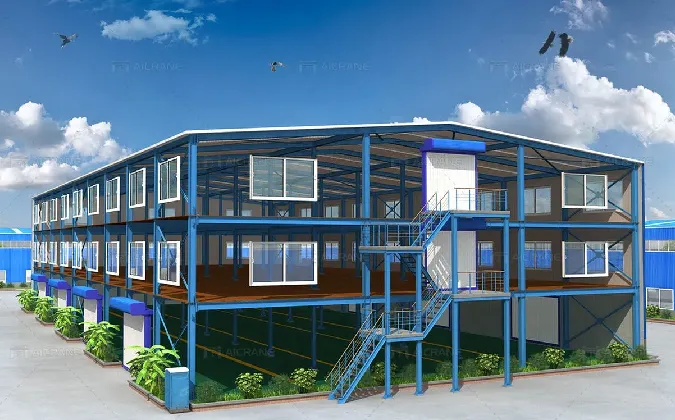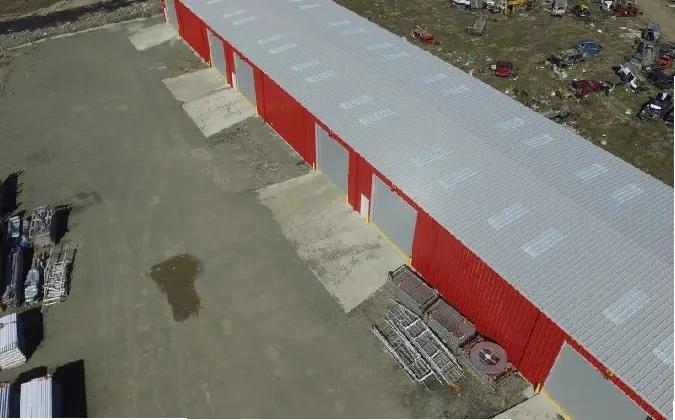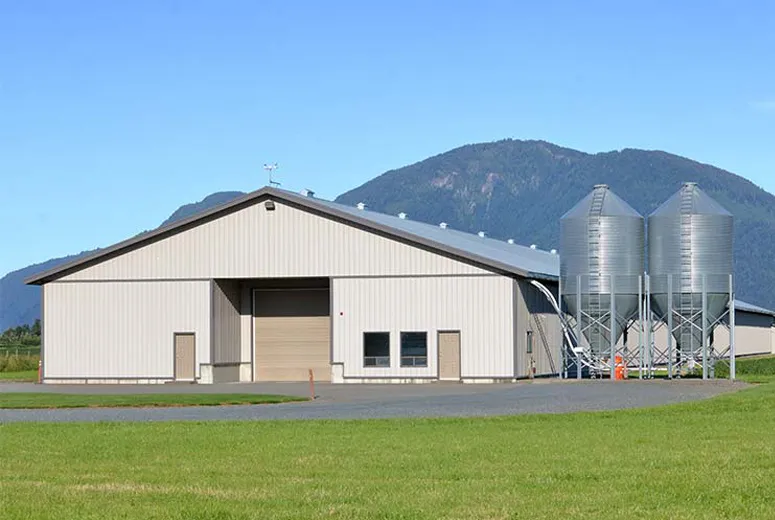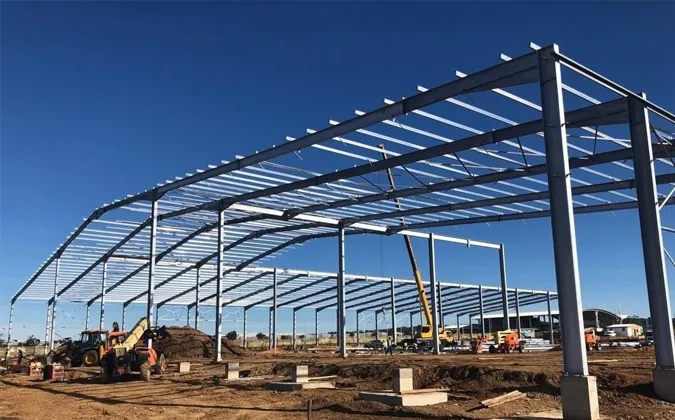Sep . 22, 2025 13:40 Back to list
Industry Trends & Overview of Modern Aviation Infrastructure
The global aviation industry is undergoing significant transformation, driven by an expanding commercial fleet, rising demand for private and cargo aircraft, and the critical need for advanced MRO (Maintenance, Repair, and Overhaul) facilities. This evolution necessitates robust, adaptable, and technologically superior infrastructure. A key component of this infrastructure is the modern airplane hangar, designed not just for shelter but also for operational efficiency, safety, and long-term cost-effectiveness. The increasing complexity of aircraft and the diversity of operational requirements have pushed manufacturers towards highly specialized and modular solutions. This is where the concept of a Customized Steel Airplane Hangar becomes paramount, offering unparalleled flexibility and performance characteristics essential for today's dynamic aerospace environment.
Current trends emphasize sustainable construction practices, rapid deployment capabilities, and smart hangar technologies incorporating automated systems for climate control, access, and asset management. The shift towards larger aircraft and specialized operational needs, such as those for defense, cargo logistics, and corporate aviation, demands structures that can accommodate varying spans, heights, and specialized equipment. Furthermore, resilience against extreme weather events and compliance with stringent environmental regulations are no longer optional but critical design considerations. The market demands solutions that are not only structurally sound but also optimized for energy efficiency and operational workflows, ensuring minimal downtime and maximum asset utilization for aviation operators, from regional airports to major international hubs and private airfields.
Hongjishunda has been a pioneer in delivering engineered steel solutions for over 15 years, building a reputation for precision, reliability, and innovative design in the industrial infrastructure sector. Our expertise spans diverse applications, making us a trusted partner for complex projects globally. Our commitment to quality is underscored by ISO 9001:2015 certification, ensuring that every project adheres to the highest international standards of manufacturing and quality management.
Manufacturing Process Flow for a Customized Steel Airplane Hangar
The development of a Customized Steel Airplane Hangar involves a meticulous, multi-stage process designed to ensure structural integrity, functional efficiency, and long-term durability. Our manufacturing process integrates advanced engineering with stringent quality control at every step.
Process Steps:
- Design & Engineering (CAD/BIM): Initial phase involves comprehensive client consultation to define operational requirements, aircraft dimensions, local environmental loads (wind, snow, seismic), and regulatory compliance. Our engineers utilize advanced CAD and Building Information Modeling (BIM) software for detailed structural analysis, stress calculations, and 3D modeling, ensuring optimal design and material utilization. This stage confirms compliance with international building codes (e.g., IBC, Eurocode).
- Material Procurement: High-grade structural steel (e.g., ASTM A572 Grade 50, Q345B) is sourced from certified mills. Materials undergo rigorous inspection for chemical composition, mechanical properties (yield strength, tensile strength), and dimensional accuracy upon arrival at our facility. Special attention is given to corrosion-resistant alloys or pre-treated steel for specific environmental demands.
- Fabrication & Cutting (CNC Machining): Steel plates and profiles are precisely cut using CNC plasma or laser cutting machines. This ensures high dimensional accuracy and minimizes material waste. Components are then pre-drilled and punched according to engineering drawings, preparing them for assembly.
- Welding & Assembly: Skilled, certified welders (AWS D1.1 compliant) employ advanced welding techniques, including submerged arc welding (SAW) and gas metal arc welding (GMAW), to join structural elements. Critical weld points undergo non-destructive testing (NDT) such such as ultrasonic testing (UT) and magnetic particle inspection (MPI) to verify weld integrity and detect any defects. Components are assembled into larger sub-assemblies for efficient on-site erection.
- Surface Treatment & Coating: All steel components undergo thorough surface preparation, typically including abrasive blast cleaning to Sa 2.5 standards, followed by the application of multi-layer protective coatings. This often includes zinc-rich primers, epoxy intermediate coats, and polyurethane topcoats, providing superior corrosion resistance (C3 to C5-I environments as per ISO 12944) and extending service life.
- Quality Control & Pre-assembly: Each fabricated part undergoes final dimensional inspection and fit-up checks. In some cases, key sections of the hangar are pre-assembled at the factory to ensure perfect alignment and ease of installation on-site. This stage also includes load testing on critical components where applicable.
- Logistics & On-site Erection: Components are carefully packaged and transported to the project site. Our experienced erection teams, following detailed construction plans and safety protocols, assemble the hangar structure. This phase typically includes foundation work, main frame erection, roofing, wall cladding, and installation of specialized hangar doors and utilities.
- Final Inspection & Handover: A comprehensive final inspection is conducted to ensure all specifications are met, safety standards are upheld, and functionality is validated. This includes structural integrity checks, utility system testing, and operational verification of doors and environmental controls, culminating in project handover and client training.
Key Materials & Testing Standards:
- Product Materials: High-strength structural steel (e.g., Q345B, Q235B, ASTM A572 Gr.50), high-performance coatings, composite insulated panels (CIPs) for cladding, specialized door systems.
- Manufacturing Processes: CNC cutting, automated welding, shot blasting, hot-dip galvanizing, multi-layer painting.
- Testing Standards: ISO 9001 (Quality Management), ISO 12944 (Corrosion Protection), ASTM (Material Standards), AWS D1.1 (Structural Welding Code), ASCE 7 (Minimum Design Loads), EN 1090 (Execution of Steel Structures).
- Service Life: Designed for a service life typically exceeding 50 years with proper maintenance, due to robust design and advanced corrosion protection.
- Target Industries: Commercial Aviation, Military Aviation, General Aviation (GA), Cargo & Logistics, MRO Facilities, Petrochemical (for specialized aircraft support), Metallurgy (for heavy-duty support structures), Water Supply & Drainage (for related equipment shelters).
This rigorous process ensures that every Customized Steel Airplane Hangar delivered meets the highest standards of safety, functionality, and longevity, contributing significantly to the operational efficiency of our clients.
Technical Specifications and Parameters
The performance of a Customized Steel Airplane Hangar is defined by its core technical specifications, engineered to withstand diverse operational demands and environmental conditions. Our designs prioritize structural integrity, thermal performance, and adaptability.
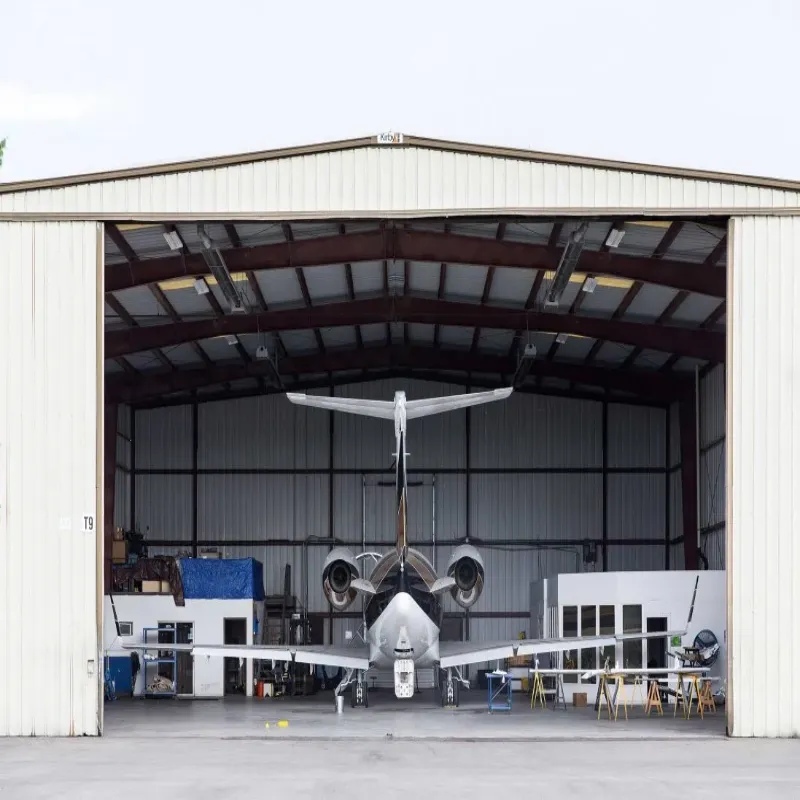
Typical Product Specification Table:
| Parameter | Description | Typical Value/Range |
|---|---|---|
| Primary Structure Material | High-strength structural steel | Q345B (Yield Strength ≥ 345 MPa), Q235B (Yield Strength ≥ 235 MPa), ASTM A572 Gr.50 |
| Secondary Structure Material | Cold-formed steel (purlins, girts) | Galvanized C/Z purlins, G350-G550 MPa |
| Roofing System | Single-skin or insulated sandwich panels | 0.5mm - 0.8mm steel sheet, EPS/PU/Rockwool core (50mm-150mm thickness) |
| Wall Cladding System | Single-skin or insulated sandwich panels | 0.5mm - 0.8mm steel sheet, EPS/PU/Rockwool core (50mm-100mm thickness) |
| Corrosion Protection | Multi-layer paint system or Hot-dip galvanization | ISO 12944 (C3-C5-I), 80-200 micron DFT, 600 g/m² galvanization |
| Wind Load Resistance | Designed to local building codes | Up to 0.8 kN/m² (equivalent to 200 km/h wind speed) |
| Snow Load Capacity | Designed to local building codes | Up to 2.0 kN/m² |
| Seismic Resistance | Designed to local seismic codes | Zone II to Zone IV (UBC/IBC equivalent) |
| Fire Rating (Cladding) | Based on core material | Up to 4 hours (Rockwool panels), B1 (PU/PIR panels) |
| Thermal Insulation (U-value) | Depends on panel type and thickness | As low as 0.18 W/m²K (150mm PU panel) |
| Typical Clear Span Range | Column-free interior space | 20m - 120m+ |
| Typical Eave Height Range | Height to lowest point of roof structure | 8m - 30m+ |
These specifications ensure that a Hongjishunda Customized Steel Airplane Hangar is not only structurally robust but also highly adaptable to specific climatic and operational requirements, offering superior performance and longevity. The choice of materials and design parameters are meticulously aligned with international standards and client operational mandates, ensuring a truly purpose-built facility.
Application Scenarios and Technical Advantages
The versatility of a Customized Steel Airplane Hangar makes it an indispensable asset across various aviation and industrial sectors. Its inherent design flexibility and robust construction offer significant technical and operational advantages.
Key Application Scenarios:
- Commercial Airline MRO: Large-span hangars accommodating wide-body aircraft (e.g., A380, B747) for heavy maintenance, routine inspections, and cabin modifications. Our customized solutions include integrated overhead cranes, utility pits, and specialized lighting for precision work.
- Military & Defense Aviation: Secure, hardened hangars for fighter jets, transport aircraft, and drones. Designs often incorporate blast resistance, enhanced security features, and climate control for sensitive equipment, ensuring operational readiness in critical environments.
- Private & Corporate Aviation: Executive hangars offering premium finishes, dedicated office spaces, lounges, and climate-controlled environments for business jets and private aircraft. Customization extends to architectural aesthetics and integrated smart building systems.
- Cargo & Logistics Hubs: Expansive hangars for cargo aircraft loading/unloading, sorting, and temporary storage. Designs optimize for rapid throughput, large door openings, and heavy-duty flooring to support ground support equipment.
- Flight Training & General Aviation (GA): Economical yet durable hangars for flight schools, FBOs (Fixed-Base Operators), and private aircraft owners, optimized for smaller aircraft and ease of access.
- Specialized Industrial Applications: Beyond aviation, these structures can serve as large-scale workshops, equipment shelters in petrochemical facilities requiring specialized ventilation and explosion-proof fittings, or heavy machinery assembly plants in metallurgy, demanding immense clear spans and high bay access.

Technical Advantages:
- Superior Structural Rigidity: Steel's high strength-to-weight ratio allows for massive clear spans (up to 120m+) without internal columns, providing unobstructed floor space crucial for aircraft maneuverability and maintenance. This is achieved through advanced truss designs or rigid frames.
- Energy Efficiency: Integrated insulated wall and roof panels (e.g., PU, PIR, Rockwool sandwich panels with U-values as low as 0.18 W/m²K) minimize thermal bridging and heat loss/gain, significantly reducing HVAC operational costs. Optimized natural lighting through skylights and translucent panels further contributes to energy savings.
- Exceptional Corrosion Resistance: Multi-layer protective coatings (e.g., zinc-rich epoxy primers, polyurethane topcoats) or hot-dip galvanization provide robust defense against environmental degradation, especially in coastal or industrial areas, ensuring a projected service life of 50+ years.
- Rapid Construction & Scalability: Pre-engineered steel components are fabricated off-site, leading to faster on-site erection times and reduced labor costs. The modular nature of steel construction also allows for future expansion with minimal disruption to ongoing operations.
- Adaptability & Customization: Steel allows for bespoke designs catering to specific aircraft types, door configurations (bi-fold, sliding, vertical lift), internal fit-outs (offices, workshops), and integration of specialized equipment like fire suppression systems, ground power units (GPU), and compressed air lines.
- Sustainability: Steel is 100% recyclable, and its durability contributes to a reduced environmental footprint over the life cycle of the structure. Our manufacturing processes also focus on minimizing waste and optimizing material usage.
- Enhanced Safety & Durability: Designed to rigorous international building codes (e.g., IBC, Eurocode) for wind, snow, and seismic loads. Steel structures offer inherent resistance to pests and fire (when properly treated), ensuring a safer environment for personnel and valuable aircraft assets.
These advantages position Hongjishunda's Customized Steel Airplane Hangar solutions as a preferred choice for operators seeking high-performance, cost-effective, and future-proof aviation infrastructure.
Vendor Comparison: Evaluating Steel Hangar Manufacturers
Choosing the right vendor for a Customized Steel Airplane Hangar is a critical decision impacting project success, budget, and long-term operational efficiency. While many manufacturers offer steel structures, key differentiators in engineering capability, material quality, customization, and service levels often dictate the true value proposition. Below is a comparative analysis based on critical parameters for B2B decision-makers.
Comparative Table of Hangar Manufacturers:
| Feature/Parameter | Hongjishunda (Example) | Competitor A (General Fabricator) | Competitor B (Pre-fab Kits) |
|---|---|---|---|
| Customization Level | Full bespoke design, adaptable to unique aircraft, site conditions, and operational workflows. | Limited modifications to standard designs. | Standardized kits, minimal customization. |
| Engineering Expertise | In-house structural, mechanical, electrical engineers. Advanced CAD/BIM, FEA for complex load analysis. 15+ years B2B experience. | Outsourced engineering or basic in-house capabilities. Focus on standard industrial buildings. | Basic structural design, often relies on client's architect/engineer. |
| Material Quality & Sourcing | Premium, certified structural steel (Q345B, ASTM A572 Gr.50) from audited mills. Traceability & MTCs provided. | Standard commercial grade steel, sometimes varied sourcing. | Often uses lighter gauge, lower-grade steel for cost efficiency. |
| Corrosion Protection | Comprehensive multi-layer paint systems (ISO 12944 C3-C5-I), hot-dip galvanization options. | Basic primer + single topcoat, limited galvanization options. | Standard primer only, requiring additional client application. |
| Certifications & Standards | ISO 9001:2015, AWS D1.1, EN 1090. Compliance with international building codes (IBC, Eurocode). | May have basic ISO, but specific industry certifications might be lacking. | Limited formal certifications, relies on general compliance. |
| Project Management & Support | Dedicated project manager, site supervision, installation guidance, comprehensive documentation, after-sales support. | Basic project coordination, limited on-site support. | Supply-only, client manages all aspects of erection. |
| Value Proposition | Long-term asset value, optimized operational efficiency, lower lifecycle costs, superior safety & compliance. | Moderate initial cost, but potential for higher maintenance and less optimal performance. | Lowest upfront cost, but limited functionality, shorter lifespan, higher operational costs. |
This comparison highlights that while various options exist, investing in a specialized manufacturer like Hongjishunda, which offers deep engineering expertise and comprehensive customization for a Customized Steel Airplane Hangar, often yields the best long-term return on investment due to enhanced performance, durability, and operational suitability.
Customized Solutions and Case Studies
The demand for bespoke aviation infrastructure is constantly growing. Our approach centers on providing truly Customized Steel Airplane Hangar solutions, meticulously engineered to meet the precise operational, environmental, and budgetary requirements of each client. This customization extends beyond mere dimensions to encompass integrated systems and specialized functionalities.
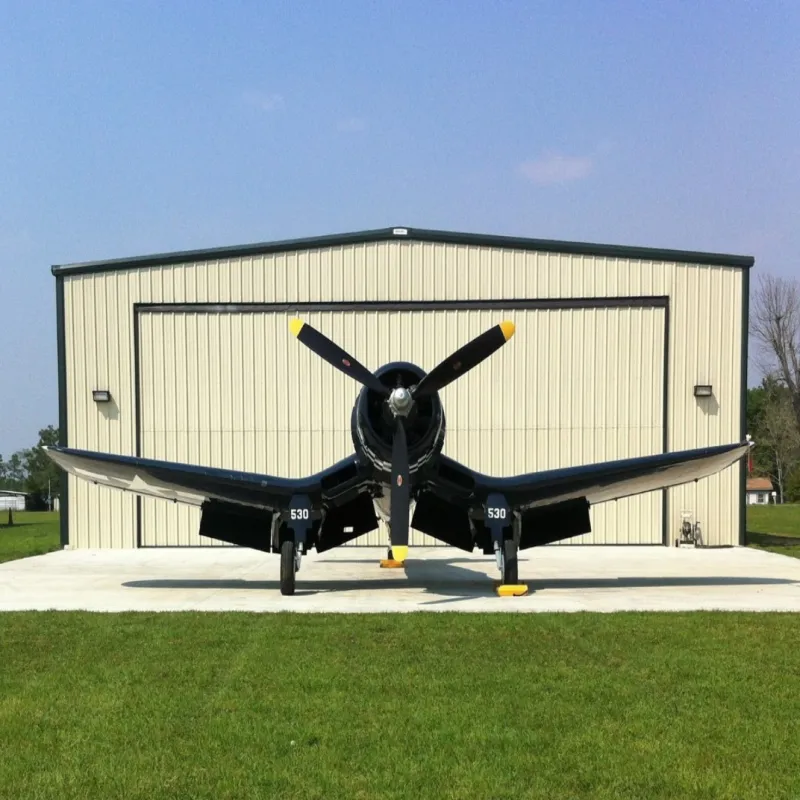
Customization Capabilities:
- Aircraft-Specific Dimensions: Tailored clear span and eave heights to perfectly accommodate specific aircraft models, from regional jets to wide-body super-jumbos, ensuring optimal use of space and regulatory compliance for clearances.
- Advanced Door Systems: Custom-designed hangar doors (e.g., vertical lift, bi-fold, sliding, fabric megadoors) with precise opening widths and heights, integrated with automation, safety sensors, and weather sealing for energy efficiency and operational fluidity.
- Environmental Control: Integration of advanced HVAC systems, dehumidifiers, and insulation packages optimized for specific climate zones, maintaining ideal temperature and humidity for aircraft maintenance and sensitive avionics.
- Specialized MRO Fit-outs: Inclusion of overhead cranes (up to 100-ton capacity), utility trenches (power, compressed air, data), fire suppression systems (e.g., foam, deluge), explosion-proof lighting, and fueling systems.
- Architectural Aesthetics & Branding: Options for custom exterior cladding, façade treatments, and color schemes to align with corporate branding or airport architectural guidelines.
- Sustainability Features: Integration of solar panels, rainwater harvesting, energy-efficient lighting (LED), and advanced building management systems (BMS) for reduced environmental impact and lower operating costs.
- Security & Access Control: Integration of advanced CCTV, access control systems, perimeter fencing, and hardened structural elements for military or high-security private operations.
Application Case Studies:
-
Case Study 1: Major International Airport MRO Facility Expansion
Client: Leading Global Airline, South East Asia.
Challenge: Expand MRO capabilities to accommodate new generation wide-body aircraft while integrating existing infrastructure. High seismic activity zone and typhoon risk.
Solution: Designed and fabricated a 100m x 80m Customized Steel Airplane Hangar with a clear span, 30m eave height. Incorporated a complex roof truss system for optimal seismic performance, specialized corrosion protection for coastal environment, and a custom multi-panel sliding door system designed to withstand extreme wind loads (up to 250 km/h). The project was completed within 14 months, 10% under budget, enabling the client to commence MRO operations for their new fleet ahead of schedule. -
Case Study 2: Remote Private Airfield for Corporate Fleet
Client: Private Corporate Aviation Group, North America.
Challenge: Construct a high-end hangar in a severe winter climate with minimal local infrastructure, requiring rapid deployment and energy efficiency.
Solution: Delivered a 40m x 35m custom steel hangar featuring highly insulated (150mm PIR panel) walls and roof for superior thermal performance (U-value 0.18 W/m²K). Integrated radiant floor heating and a bi-fold door system with extra heavy-duty seals. The pre-engineered and pre-fabricated components allowed for a 6-month construction timeline despite challenging weather conditions, significantly reducing heating costs for the client. Client feedback highlighted the "seamless integration of luxury finishes with industrial-grade functionality." -
Case Study 3: Military Logistics Hangar, Middle East
Client: National Defense Force, GCC Region.
Challenge: Require a large, secure facility for drone maintenance and storage in an extremely hot, dusty environment, with stringent blast and ballistic protection requirements.
Solution: Fabricated a 60m x 40m hangar incorporating reinforced concrete blast walls internally and a robust steel frame designed for enhanced structural hardening. Specialized HVAC with advanced filtration systems was integrated to mitigate dust ingress and maintain optimal temperatures. Exterior cladding utilized high-reflectivity coatings to minimize heat absorption. Project delivered on time, meeting all classified security specifications.
These cases exemplify our capability to deliver complex, high-performance Customized Steel Airplane Hangar solutions that exceed client expectations and perform robustly in diverse and demanding environments.
Trustworthiness & Client Support
At Hongjishunda, establishing and maintaining client trust is paramount. Our commitment extends beyond the delivery of a superior Customized Steel Airplane Hangar to encompass transparent processes, robust support, and clear commitments.
Frequently Asked Questions (FAQ):
- Q: What is the typical lead time for a customized steel airplane hangar?
- A: Lead times vary significantly based on design complexity, size, and current manufacturing load. Generally, expect 8-12 weeks for detailed engineering and fabrication, followed by 4-16 weeks for shipping and on-site erection. Rush options may be available for critical projects.
- Q: What warranty is provided for the steel hangar structure?
- A: We offer a standard 25-year structural warranty against manufacturing defects and material failure, contingent on adherence to recommended maintenance schedules. Specific coating warranties (e.g., 10-15 years for premium paint systems) are also provided.
- Q: Can your hangars be relocated or expanded in the future?
- A: While primarily designed for permanent installation, the modular nature of our steel structures allows for significant adaptability. Expansion is relatively straightforward with proper planning. Relocation is possible but often requires substantial re-engineering and logistical effort.
- Q: What kind of foundations are required for your steel hangars?
- A: Our engineering team specifies the precise foundation requirements (e.g., concrete slab, isolated footings, pile foundations) based on local soil conditions, seismic data, and the specific structural loads of the hangar. A detailed foundation drawing package is part of our design output.
Lead Time & Fulfillment:
- Design & Engineering: 4-6 weeks (after client brief approval).
- Fabrication: 8-12 weeks (post-design approval and material procurement).
- Shipping & Logistics: 2-6 weeks (depending on destination).
- On-site Erection: 4-10 weeks (for typical hangars, larger or more complex projects may take longer).
- We provide a comprehensive project schedule at contract signing, with regular updates to ensure transparency.
Warranty Commitments:
- Structural Integrity: 25-year limited warranty on primary steel framework.
- Corrosion Protection: 10-15 year limited warranty on specified paint systems or galvanization (subject to environmental conditions and proper maintenance).
- Cladding & Roofing: 10-year limited warranty on panels against material defects.
- Doors & Ancillary Equipment: Manufacturer's warranty, typically 1-5 years.
Customer Support Information:
- Dedicated Project Manager: Each project is assigned a single point of contact for streamlined communication.
- Technical Support: Our engineering team is available for post-installation technical inquiries and maintenance guidance.
- Maintenance Manuals: Comprehensive O&M (Operations & Maintenance) manuals are provided upon project completion.
- Spare Parts: We maintain a database of all project-specific components and can facilitate the supply of spare parts throughout the hangar's lifecycle.
Our robust support infrastructure ensures that your investment in a Hongjishunda hangar is protected and operational for decades to come.
Conclusion & References
The intricate demands of modern aviation necessitate infrastructure that is not merely functional but also highly engineered, adaptable, and resilient. The Customized Steel Airplane Hangar stands as a testament to this requirement, offering unparalleled benefits in terms of structural integrity, operational efficiency, and long-term value. From sophisticated engineering and material science to advanced manufacturing and meticulous project management, the development of these hangars is a complex undertaking that requires specialized expertise.
Hongjishunda's commitment to delivering tailored solutions, backed by rigorous quality standards, extensive industry experience, and a client-centric approach, ensures that our hangars serve as critical assets for the global aviation sector. By integrating cutting-edge technology with robust steel construction, we empower our clients to optimize their MRO operations, secure their assets, and scale their capabilities in an ever-evolving aerospace landscape. The strategic investment in a customized steel hangar is an investment in future readiness, operational excellence, and enduring infrastructure.
Authoritative References:
- American Institute of Steel Construction (AISC). Specification for Structural Steel Buildings. 2016. aisc.org
- International Code Council (ICC). International Building Code (IBC). 2021. iccsafe.org
- ISO 9001:2015. Quality Management Systems - Requirements. International Organization for Standardization. iso.org
- ISO 12944-2:2017. Paints and varnishes - Corrosion protection of steel structures by protective paint systems - Part 2: Classification of environments. International Organization for Standardization. iso.org
- American Society of Civil Engineers (ASCE). Minimum Design Loads and Associated Criteria for Buildings and Other Structures (ASCE 7). 2022. asce.org
-
Bolted Connections in Steel Frame Warehouse
NewsNov.17,2025
-
Hay Storage in Farm Metal Buildings
NewsNov.17,2025
-
Advantages of a Steel Portal Frame Shed
NewsNov.17,2025
-
The Erection Process of a Steel Building Hangar
NewsNov.17,2025
-
Energy Efficiency of Steel Dome Garage Kits
NewsNov.17,2025
-
Fire Resistance of Kit Metal Garages
NewsNov.17,2025
Products categories
Our Latest News
We have a professional design team and an excellent production and construction team.








